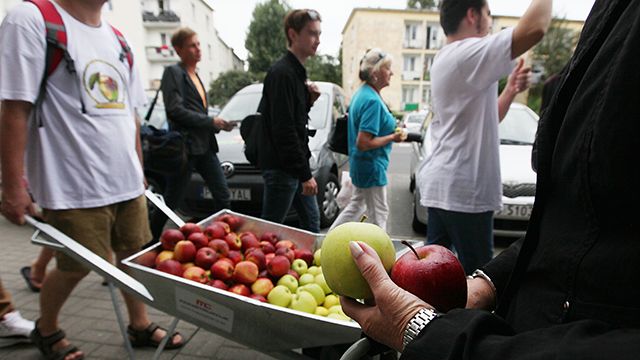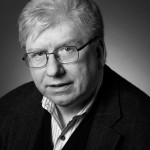
WARSAW — People in Poland are eating apples these days. Lots of apples. Here in Warsaw, they’re pressed into your hands at a street festival, or baked into piles of pies and cakes. You see them everywhere.
It’s an act of defiance. Moscow has banned the importing of fruits and vegetables to Russia, in retaliation for the West’s sanctions against the country for supporting the separatists in Ukraine. Last year, Poland sold more than $400 million worth of produce to Russia, 90 percent of it apples. Now that market has disappeared.
So Poles are being urged to eat apples and then eat some more. It’s their patriotic duty. Cider sales have skyrocketed. Janusz Palikot, a controversial Polish businessman and politician declared to a local magazine, “Russia doesn’t want our apples? Then let’s make jam and booze!” The Polish ambassador to the US has even pronounced them “Freedom Apples,” in the dubious tradition of “Freedom Fries,” urging Yanks to take up the slack and buy more from Poland.
We were in Warsaw for the International Affiliation of Writers Guilds and the third World Conference of Screenwriters, part of the group representing the United States at several days of panels, meetings and receptions. Throughout, the conversation was lively and informative. Andrzej Wajda was there, the grand old man of Polish cinema. So was Andrew Davies, creator of the original TV version of “House of Cards” and countless other British adaptations; and so were several Scandinavian writers, flush with the success of such innovative television series as “The Killing,” “The Bridge,” and “Borgen,” the story of a woman Danish prime minister.
What almost never came up, even with the many Poles in attendance, was the 500-pound-gorilla that wasn’t precisely in the room, but just 700 or so miles away. A couple of weeks before, a German newspaper reported that Russian President Vladimir Putin allegedly had told Ukrainian President Petro Poroshenko, “If I wanted, in two days I could have Russian troops not only in Kiev, but also in Riga, Vilnius, Tallinn, Warsaw and Bucharest.”
It’s a sobering thought but not likely, most of those with whom we spoke claimed. Maybe their optimism is partly the ongoing euphoria of a nation that has largely escaped the economic meltdown of 2008 and that seems for the most part to have embraced democracy – Poland just celebrated the 25th anniversary of its first post-World War II, non-Communist government, not to mention the 25th anniversary of the fall of the Berlin Wall.
Poland is now a member of NATO and the European Union – in fact, the new president of the European Council is Donald Tusk, the Polish prime minister whose successor in Warsaw is Ewa Kopacz, a chain-smoking physician who used to carry a stethoscope in her purse and wrote prescriptions for fellow members of parliament. She recently took some heat when she told a press conference that “Poland should act like a reasonable Polish woman,” protecting her children first instead of heedlessly jumping into a fight – like a man.
Nonetheless, in some places, there is definitely a low hum of anxiety. But Article V of NATO’s founding treaty says that “an attack on one is an attack of all,” meaning, in theory at least, that the armed forces of Britain, France, Germany and the US, among others, would come to Poland’s defense. And a new NATO rapid response force is being headquartered here. Vladimir Putin may be boastful, many Poles think, but not foolhardy. Besides, he has his hands full with Ukraine, not to mention Chechnya and a host of other problems within. Then again, given Putin’s past actions in Georgia and Crimea, would Poland’s allies stand strong in the face of further, greater aggression?
Over the centuries, after all, Poland has experienced otherwise. For one, after Neville Chamberlain’s “peace in our time” deal with Hitler collapsed in 1939, Britain and France pledged to protect the integrity of the Polish state but the promise evaporated when Germany invaded on September 1 of that year. World War II began. And the Holocaust exploded, especially here in Poland, where virulent anti-Semitism already ran deep. We spent a dark and rainy day walking through the mud of the Auschwitz and Birkenau concentration camps, the rows of barracks, cells, gas chambers and crematoria where 1.1 million Jews were exterminated as well as thousands of Polish political prisoners, Soviet POW’s, Romani, homosexuals and even Jehovah’s Witnesses.
“Death, death, death,” a survivor recalled. “Death at night, death in the morning, death in the afternoon. Death. We lived with death. How could a human feel?”
In 1943, the Warsaw Ghetto Uprising began, Polish Jews fighting back against their forced removal to the death camps. Several hundred held off the Germans for a month but their resistance was crushed. A new Jewish museum, opening in Warsaw at the end of the month and located in what once was the ghetto’s center, tells that story and chronicles 1000 years of Jewish history in Poland. But today the government estimates there are only 15,000 Jews in the country. Before the war, there were as many as 3.5 million.
A year after the ghetto battles, another Warsaw uprising, led by the Polish Home Army in 1944, hoping to take the city from the Nazis as the Soviet army approached from the east. Two months of fierce fighting were futile. Another defeat and 200,000 more were killed.
By the time World War II ended, 85 percent of Warsaw was in rubble. That so much of it has been restored so magnificently is a miracle, especially in the Old Town where we stayed and where so much of the street-to-street fighting during the 1944 uprising took place. Plaques and monuments are everywhere.
The last night we were in Warsaw was the 70th anniversary of the end of the ’44 uprising. Boy Scouts – who all those decades before had risked their lives as a sort of postal service for the resistance, stealthily delivering messages around the city – lit thousands of candles. They were carefully placed all along streets that paralleled from above the routes of the underground sewers through which soldiers and citizens had been forced to flee.
The candles, like the apples, are symbols of resilience in the face of adversity. The tenacity and desire for freedom they represent are why so many of the Poles, despite their history of enmity from within and without, and the fear of future conflict, seem determined to live in hope.

This work is licensed under a Creative Commons Attribution-NoDerivatives 4.0 International License.


